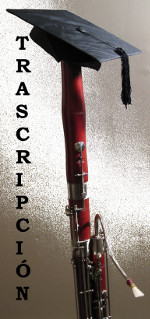REFLECTION 沉思
REFLECTION沉思
1. I suppose it is tempting, if the only tool you have is a hammer,
to treat everything as if it were a nail.—Abraham Maslow
1.Supongo que es tentador, si la única herramienta que tenemos
es un martillo, tratar todo como si fuese un clavo. -Abraham Maslow.
ref. Abraham H. Maslow (1966). The Psychology of Science.p. 15. As quoted from https://en.wikipedia.org/wiki/Law_of_the_instrument.
2. So far in the studies we have already considered many tools for practicing. In this reflection I present the notion of a toolbox full of methods for practicing the bassoon.
2.A lo largo de los estudios hemos considerado muchas herramientas
para practicar. En esta reflexión presento la noción de
una caja de herramientas llena de métodos para practicar fagot.
3. Abraham Maslow’s quotation about the hammer illuminates the absurdity of trying to fix every problem with a single tool. Likewise by now you should understand that the difficulties presented in the Weissenborn studies will not be fixed with a single approach to practicing.
3.La cita de Abraham Maslow sobre el martillo arroja luz sobre lo
absurdo que es tratar de solucionar todos los problemas con la misma
herramienta. Igualmente, por ahora deberíais entender que las
dificultades presentadas en los estudios de Weissenborn no se
superarán utilizando un solo enfoque de práctica.
4. You need to have a “tool box” filled with practice
solutions for different problems. You also need to have the wisdom to
know which tool can be used to fix the problem. Hopefully you are
beginning to understand the application of some of the tools I have
present in the last 20 studies. More tools are yet to come!
4.Necesitáis una “caja de herramientas” provista
de soluciones prácticas para diversos problemas. También
necesitáis tener la sabiduría para saber qué
herramienta es necesaria para solucionar el problema. Espero que
estéis empezando a entender el uso de algunas de las
herramientas que os he presentado en los últimos 20 estudios.
¡Hay más herramientas en camino!
5. Here for instance is an inventory of some the practice tools in my box with some references:
5.Aquí, por ejemplo, tenéis un inventario de algunas
de mis herramientas de práctica en mi caja, con algunas
referencias:
6.
- A metronome for beat displacement, accuracy, tempo, and timing, (Weissenborn #22, BDP#130),
- Rhythms (Weissenborn #24, BDP#132),
- Subdivisions (this study, BDP #129),
- Drones (Weissenborn #1, BDP#109)
- Rubato drives (Music in Motion, BDP#100),
- Vibrato drives (Music in Motion, BDP#100),
- Trill practice (Weissenborn #37, BDP#145),
- Endurance exercises (“Wind Performer’s Guide to Increasing Endurance”).
6.
-Un metrónomo para desplazamiento rítmico, precisión, tempo y medida (Weissenborn #22, BDP #130),
-Ritmos (Weissenborn #24, BDP #132),
-Subdivisiones (este estudio. BDP #129),
-Pedales (Weissenborn #1, BDP #109),
-Rubato (Musica en movimiento, BDP #100)
-Vibrato (Música en movimiento, BDP #100),
-Práctica de trinos (Weissenborn #37, BDP #145),
-Ejercicios de resistencia (“Wind Performer’s Guide to Increasing Endurance”).
7.
- A mirror (Weissenborn #2, BDP 110),
- A recording device, which could be an app on your phone or computer,
- Alternate fingerings such as those in the Bassoon Family Fingering Companion(http://www.idrs.org/resources/bsnfing/finghome.htm),
- Segmentation (Weissenborn #11, BDP#119),
- And sprints (Weissenborn #11, BDP#119).
7.
-un espejo (Weissenborn #2, BDP 110),
-un dispositivo para grabar, que puede ser una aplicación, vuestro teléfono o un ordenador,
-Digitaciones alternativas como las publicadas en la “Bassoon
Family Fingering Companion (
http://www.idrs.org/resources/bsnfing/finghome.htm)
-Segmentación (Weissenborn #11, BDP #119)
-Sprints (Weissenborn #11, BDP #119).
8. It is critical that you use the right tool for the right problem
and then devote the practice time needed for mastery. In addition, use
all of these tools to develop your musical acuity, that is, the ability
to understand and hear all aspects of music. Develop your musical ear
and your musical imagination not just technical facility. The goal is
to be a musician not a machine.
8.Es importantísimo que uséis la herramienta adecuada
para cada problema en concreto y que dediquéis el tiempo
necesario para dominarlo. Además, usad todas estas herramientas
para desarrollar vuestra agudeza musical, esto es, la habilidad de
entender y escuchar todos los aspectos de la música. Desarrollad
vuestro oído e imaginación musical, no solo la facilidad
técnica. La meta es ser músico, no una máquina.
CREDITS 感谢
References for the discussion of mordents.
Weissenborn, Bassoon Studies Opus 8/1, For Beginners. (London: Edition Peters), page 42.No. 2277a.
Weissenborn, Bassoon School with Complete Theoretical Explanations. (Rob. ForbergMusikverlag), page 53.
